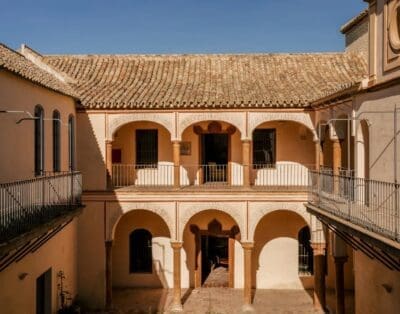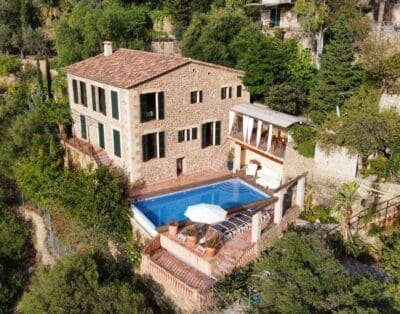David’s Dram Diaries – Issue 2
GlenDronach
The first ever bottle of serious whisky I purchased (that is non-supermarket) was a GlenDronach, so it holds a special place in my heart. In September I was able to visit the distillery for the first time and enjoy a tour and tasting, in a rather opulent room whilst sitting at a large round table. We compared their sherry cask matured whiskies alongside the styles of sherry that had been in the sherry butts prior to the whisky.
The distillery and grounds were beautiful and the history of the distillery was fascinating, with its ebbs and flows. It did feel like a pilgrimage, and one where I had to buy a handfill bottle, but more of that later.
The roots of the GlenDronach Distillery can be traced back to 1826 when it was founded by James Allardice, a passionate whisky enthusiast. Located in the fertile valley of Forgue, in the heart of Aberdeenshire, GlenDronach quickly gained a reputation for producing rich and full-bodied whisky. The name “Glendronach” itself is derived from the Gaelic language and translates to “Valley of the Blackberries.”
In the early years of GlenDronach’s history, The distillery relied on direct-fired stills and sherry casks for maturation, a practice that set it apart from many of its contemporaries and laid the foundation for a distinctive style that still defines Glendronach today.
As with so many distilleries, over the years, GlenDronach has faced its share of challenges, including the effects of economic downturns, world wars, and changes in the whisky market. But it has survived and even became a trailblazer in 1960 when it became one of the first distilleries in Scotland to install a coal-fired still.
Turbulent times meant the distillery was mothballed in 1996 and not reopened until 2002 when a 12,15 and 18-year-old were released and continue to be to this day. Prior to this, the whisky had been used in blends, most notably Teachers, which now seems an absolute travesty given the quality.
Sherry cask maturation has become their trademark. You expect GlenDronach to be rich, with dark fruit notes, a balanced sweetness, and a full-bodied character and in general they all are as you can see from my notes below.
GlenDonach 18 Allardice at 46% – £170
Fruitcake on the nose with toasted barley. The palate is spicy, rich, and full of that delicious fruitcake soaked in booze. The length is remarkable and leads into liquorice notes.
GlenDronach Cask Strength Batch 10 at 58.6% – £75
Less pronounced fruitcake on the nose than the 18 but really packing a punch. The additional alc gives accelerated spice notes and brings out ginger and fig. I also found chocolates, almonds and ginger. Great value.
GlenDronach Handfill Pedro Ximenez Puncheon Cask No 4597. 12 years old at 62.9% – £128
The PX flavours hit you immediately – rich, bold and inviting. Almost creamy on the nose with toffee and vanilla fudge. The palette is powerful, some may add water to open it up a little. Dark cherry, raisins, tobacco and liquorice dance around in your mouth. Again a great length with the flavour dominant minutes later.
GlenDronach Handfill Olorosso Puncheon Cask No 2463. 30 years old and 55.5% – £790
It is always a treat to taste any whisky of this age, but a Glendronach especially. The nose is sublime, reminding me of chocolate with a caramel centre. Underneath that rich deep marmalade flavours emerge intermingling perfectly. I could imagine it being a gnarly teenager who has matured into a fine individual. The consistent fruitcake is ever present alongside baking spices and barley. What struck me is how balanced the whisky is on the palate having added just a drop of water – it opened the whisky up and took away the alcohol component allowing the flavours to shine.
Glendronach
Great Drams
I have a particular passion for Independent Bottlers, as effectively they are living the dream I wish I could fulfil, short of owning a distillery. Great Drams came to my attention a few years ago having won a number of awards, so I purchased a few bottles. I now do some photography for them so have been able to taste a great number of their 50+ releases to date.
What I love is the variety and the quality, often from distilleries I have not had the opportunity to taste before. This is especially true for both malt and grain distilleries whose whisky usually forms one of the components of a a major blended whisky. They are rarely seen, if at all as distillery bottles, but some find their way to independent bottlers, like Great Drams. Not only is it fascinating to taste these whiskies, it is also unique and makes for a great taking point when sharing with friends.
Each time I speak with Greg, the founder with his wife Kirsty, I hear genuine passion in their voices and excitement about their latest release. I love that! Greg is very well thought of in the industry, writes for Whisky Magazine and judges at major competitions. This alone should convince you that they would never put out a bottle which they themselves find truly tasty.
The advantage you have with Great Drams is that most bottles come in 50cl and 20cl, allowing you to conduct comparative tastings with your whisky-loving friends with ease. Just buy a 20cl each and get together to enjoy with your favourite foods one evening. Whisky is about people ultimately, so what better way than to have a tasting and discuss what is in your glass?
Here are a few bottles that I particularly recommend. They also make superb presents for Christmas.
Glen Moray 7 at 48.2% – £25 for 20cl and £55 for 50cl.
If you like classical Speyside whisky this is for you. Full of delicate orchard fruits, vanilla and balanced oak.
Invergordon 20 at 48.2% – £65 for 20cl and £150 for 50cl
There is something special about these mature grain whiskies. They almost take on a single malt flavour. This is light in colour but rich in flavour from maturation in a sherry cask. Think damsons and vanilla custard and you get the idea. The vast majority of Invergordon goes into blends so a real treat to have this one. Delicious and an award winner.
Caol Ila 9 at 48.2% – £35 for 20cl and £75 for 50cl
This is a beautiful example of how good young Caol Ila can be. It has lovely aromas of integrated smoke, but not harsh or overpowering. The palate is alive with butterscotch and underlying orchard fruits, making it perfect for this time of year.
Great Drams
Spey Bar
I had a fantastic evening last Thursday at the Spey Bar, tasting a selection of Bruichladdich whiskies from Islay. The bar, situated on the first floor of the recently renovated Browns Hotel, located on St. Martins Lane near Covent Garden, offers a truly opulent and unique location.
The interior of the Speybar is distinctive, characterised by its Grade II listed status as the former Westminster County Courtroom, complete with original features, including the judge’s bench, and even the historical signage directing towards the former cells. Fortunately, I was well behaved and not led down!
Spey Bar is operated by the team behind the renowned Quaich Bar at the Craigellachie Hotel in Scotland, so comes with pedigree. It is nice to see such an historic bar have a London presence – it will only serve to bring back memories for so many.
The whisky selection is continually expanding, and the guidance of Dan, the bar manager and whisky curator, is readily available to assist you in your choice. Although there is an array of Scottish beers and even the iconic Irn Bru, personally, I prefer to enjoy a whisky with the Scottish-themed bar food menu. Items on offer include a Haggis Scotch egg, scallops and black pudding and cullen skink croquettes, which are all exceptional.
I enjoyed the following delicious drams of Bruichladdich at the tasting-:
Classic Laddie – beautifully subtle and fantastic in a High Ball.
Bere Barley – wonderful notes of the barley came through – really beautiful.
Port Charlotte 10 – wonderfully balanced, rich and peaty.
Octomore 14.2 – full of red fruits and spices under the smoke
Octomore 14.3 – Stone fruits, toffee and full-on smoke.
I particularly enjoyed this tasting as I visited the distillery around a year ago, but had not tasted the Octomore 14.2 or 14.3. The No. 14 represents the release and the following number is its style. I previously wrote about this in my article on the distillery which you can read here.
The pricing is attractively positioned, making it an ideal destination in central London to meet with friends or enjoy a pre-theatre drink. My picks would be the Glendronach 15 Revival at £8.10, Glenrothes 18 at £10.75, Bunnahabhain 18 at £11, Bruichladdich Octomore 13.3 5 17.50 and the Glenfarclas 25 at £20.
Spey Bar
Bushmills
Bushmills recently invited me to a lovely evening at the Sager + Wilde restaurant in London. This exclusive dinner started with a tasting featuring four wines, guided by sommelier Bryn Lovell. Bryn gave descriptions of the wines and the flavours we might expect to find in them.
The hard work then started when we had to match the 4 wines to four whiskies that were currently being matured within the corresponding wine casks. The challenge for our palates was to detect which wine corresponded with which whiskey. This proved to be quite challenging, and I, regrettably, could successfully identify only two of them successfully. A little embarrassing!
Among the whiskies, I was pleased to discover my personal preference for the Barolo cask finish, which is consistent with my natural inclination toward whiskies aged in red wine casks. This expression resonated with me for its range of flavours, offering notes of roasted chestnuts, plums, and orchard fruits. The palate came to life with an interplay of spice, damson compote, and velvety vanilla ice cream. My entreaty to the hosts: please consider bottling this exceptional whisky for us – it was delicious. The other whiskies featured in the lineup included a Pinot from Burgundy, a pink Champagne, and a Jura cask.
During dinner, we had the privilege of tasting the Bushmills 25-year-old and 30-year-old. Of these, the 30-year-old stood out as a personal favourite, characterised by the sheer array of flavours, as well as a balance that was wonderful. It was, in every sense brilliant.
Having first enjoyed Bushmills back in 1989 as a 17-year-old, I really enjoyed tasting a wider variety of expressions. So much so, that I am going to try and fit a trip to the distillery next year.
Bushmills
Jameson
I attended the launch of the new Jameson Whiskey Anthology release “Caribbean Beats” in East London at the very hip (do people still use that phrase?) TT Liquor.
We were treated to some fantastic cocktails made with Jameson Black Barrel, my favourite being the Caribbean Coupe with Havana Club 7, PX Sherry, vermouth, pomegranate spirit and walnut bitters.
Before trying the new release we had the opportunity to sample the constitute parts that go into the blend. These are 18-year-old still and grain whiskeys aged (separately) in Four Square Rum barrels before spending 3 further years finishing in Havana Club barrels. It was a lot drier than I was expecting which I liked. The tropical notes you would expect such as caramelised pineapple, mango and vanilla spice were all present and the whiskey had a lovely length. I also got toasted hazelnuts and some cloves coming through on the finish. Very drinkable indeed.
Caribbean Beats has been released in limited quantities at £280 for a 500ml bottle.
Jameson
Eight Reserve by 818 Tequila
It is always nice to venture away from brown spirits and explore the world of Tequila. Forget what you think you know about this Mexican drink, and banish memories of shots in the bar to the back of your mind. Away from the industrially made bottles by the mega brands, there is a world of flavour to be explored, many of which you might not expect. Before I summarise the Eight Reserve, it is important to refresh your knowledge of what tequila is.
Tequila can only be made in 5 states of Mexico with Jalisco being the main one. It is made from the Blue Agave plant which takes at least 6 years to grow. In extremely simple terms It is harvested, baked, pressed, fermented and then distilled twice. It is then bottled or aged, and labelled according to the length of ageing. The main terms used are:-
Blanco – bottled immediately or up to 2 months in a barrel.
Reposado – 2-12 months is a barrel.
Añejo – 12-36 months in a barrel with a maximum capacity of 600L
Extra Añejo – a minimum of 3 years in barrel with a maximum capacity of 600L
Regulations state that a Tequila must be made with a minimum of 51% Blue Agave, the remainder being a spirit made from sugar cane. Premium Tequila will almost always be made from 100% Blue Agave, and it will state that on the label.
The Eight Reserve is a blend of Añejo and Extra Añejo Tequilas which have been aged in French and American barrels for up to 8 years. The Burgundian barrels are 5th fill (Chardonnay) and made by Les Tonnelleries de Bourgogne. It is bottled in handmade ceramic decanter in the shape of the number 8, and produced by locals in Pachuca, Mexico.
818 Tequila is a B-Corp, confirming its commitment to the planet and its staff. The distillery runs entirely off biomass and solar power (a lot easier in Mexico than in the UK!) which is great to know. They use the leftover agave fibres and liquids by combining them with adobe soil to make bricks. These are then shared locally, including in a library they are building in Zapotitlán de Vadillo.
Eight Reserve at 40% and £275
This has a light golden colour and caramel, apricot tarte tatin and vanilla ice cream are all there in the nose. This opens up after a while with floral tones coming to the fore. In the mouth, the barrel ageing gives a subtle spice complementing the ever-present apricot. It is relatively complex with vanilla and marmalade showing. It has a very pleasing creaminess to it and moderate length. A sipping Tequila.
You can purchase Eight Reserve from Harvey Nichols







